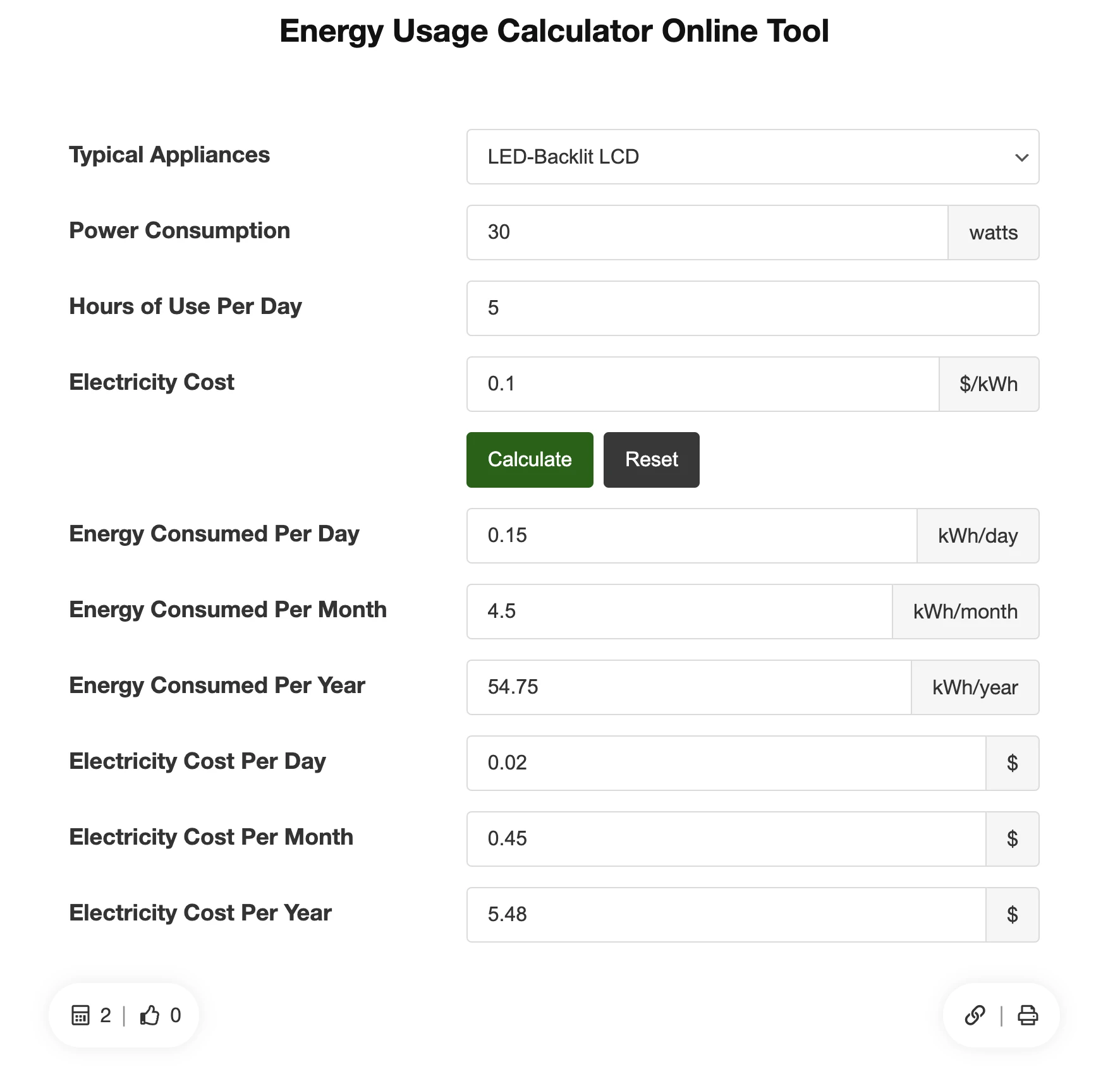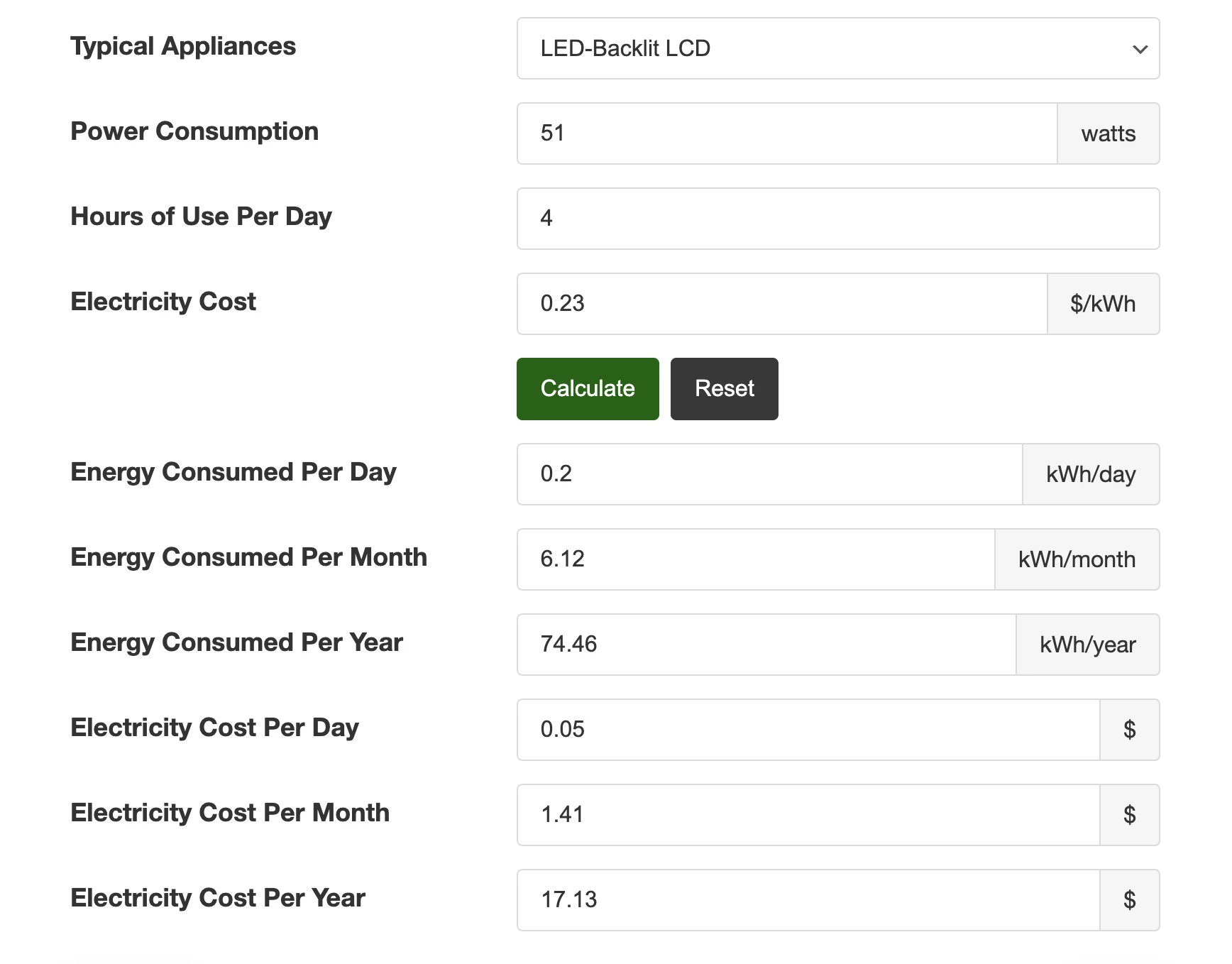Energy Usage Calculator: LCD/LED Display and TV Screen
Understanding the power consumption of our everyday devices like computers and TV displays is crucial in these energy-conscious times. This consumption is influenced by a multitude of factors, including the display technology, the manufacturer’s design and build quality, screen size, the type of content displayed, the screen’s brightness, and whether power-saving modes are engaged.
For instance, consider a 24-inch LED-backlit LCD display from a reputable manufacturer, which is rated at 30 watts for use 5 hours per day at a cost of $0.10 per kW.
From the results of the calculator, we can see that the daily cost of operating a 24-inch LED-backlit LCD display is estimated to be around $0.02.
While this may seem minuscule, when extrapolated over a month, the cost rises to approximately $0.45. Over the course of a year, these daily costs accumulate to an estimated $5.48. Moreover, the display consumes around 0.15 kWh of energy per day.
Energy Usage Calculator Online Tool
The formula:
- Daily Energy Consumption: (p × h) / 1000
- Monthly Energy Consumption: ((p × h) / 1000) × 30
- Yearly Energy Consumption: ((p × h) / 1000) × 365
- Daily Electricity Cost: ((p × h) / 1000) × r
- Monthly Electricity Cost: (((p × h) / 1000) × 30) × r
- Yearly Electricity Cost: (((p × h) / 1000) × 365) × r

Where:
- “Hours Used Per Day (h)” is the average amount of time you use the device each day. If you use the device for less than an hour daily, input the time as a decimal. For instance, if you use the device for 30 minutes every day, enter “0.5”.
- “Power Consumption (p)” refers to the average amount of electrical energy the device consumes, measured in watts. This value signifies the rate at which the device consumes energy.
- “Price/Electricity Cost per Unit (r)” is the average cost you pay for every kilowatt-hour (kWh) of electricity. The calculators use a base cost of $0.23 per kWh or 23 cents. To get a precise cost, you can refer to your electricity bill
FAQs
Our online tool is specifically designed to simplify the process of calculating power consumption for different devices. By inputting the device’s power consumption, wattage rating, and the daily usage duration, our calculator provides an estimate of energy consumption in kWh per month, year, and beyond.
With this user-friendly tool, determining the power needs of your devices has never been easier.
CRT Monitor (Cathode Ray Tube): CRTs are the oldest type of monitor and use a heavy and bulky cathode ray tube to display images. They consume the most power among these types, around 100 watts for a 19-inch display.
LED Monitor (Light Emitting Diodes): These monitors are known for their slim design and high-quality images. They provide excellent color accuracy and are energy efficient, consuming around 20 watts on average for a 19-inch display.
LCD Monitor (Liquid Crystal Display): LCD monitors are widely used due to their affordability and decent image quality. They use liquid crystals to create images, consuming about 22 watts for a typical 19-inch display.
OLED Monitor (Organic Light Emitting Diodes): OLEDs offer the best color contrast and display the deepest blacks. These monitors are very thin and flexible, consuming about 21 watts for a 19-inch display.
Plasma Monitor: Plasma screens provide high-quality images and excellent color accuracy. They are less common now due to their high power consumption and weight, consuming 38 watts for a 19-inch display.
| Monitor Screen Size | Plasma (Watts) | LED (Watts) | LCD (Watts) | CRT (Watts) |
|---|---|---|---|---|
| 15 inches | N/A | 15 | 18 | 65 |
| 17 inches | N/A | 18 | 20 | 75 |
| 19 inches | N/A | 20 | 22 | 80 |
| 20 inches | N/A | 24 | 26 | 90 |
| 21 inches | N/A | 26 | 30 | 100 |
| 22 inches | N/A | 30 | 40 | 110 |
| 24 inches | N/A | 40 | 50 | 120 |
| 30 inches | 150 | 50 | 60 | N/A |
| 32 inches | 160 | 55 | 70 | N/A |
| 37 inches | 180 | 60 | 80 | N/A |
| 42 inches | 220 | 80 | 120 | N/A |
| 50 inches | 300 | 100 | 150 | N/A |
The power consumption of a monitor in Sleep Mode typically ranges between 5 to 10 watts. While these numbers are average, slight variations in power consumption may occur.
Compared to active use, the power consumption of a monitor in Sleep Mode is significantly lower, resulting in potential savings on your electricity bill.
Computer monitors, a crucial component of any desktop computing ensemble, typically utilize power in the range of 20 to 300 watts.
This power consumption is influenced by a number of factors, including the monitor’s screen size, model, and the type of content displayed.

For instance, the daily power utilization of a conventional LG 27GL83A-B 27-inch monitor (51W), when used for approximately 4 hours with Electricity Cost (0.23), equates to roughly $1.41 per month and 17.13 per year.
Tags: monitor
Pete is a software engineer who currently works full-time managing OMGMonitor.com. On the side, he enjoys coding his own projects and spending time with his wife and two dogs. When he's not working or hanging out with family and friends, you can find him playing the guitar or running. My Instagram.






